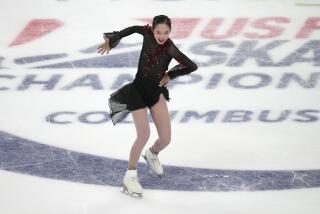Sochi Olympics: Things I learned as a competitive figure skater
If I had landed that double loop, I might remember very little about one of my last performances as a figure skater. It’s a jump I had done, in competition and in practice, probably hundreds of times. But on that day, during my last shot at a medal in regionals, I fell. My elbows hit the ice, my chest and neck jolted back and my head soon followed.
It’s not as bad as it might sound. The French braid on the back of my head acted as a helmet as I knocked the ice. But it wasn’t your average tumble -- if you only watch figure skating on TV, you’ve probably not seen a fall like it. One person told my mom afterward that she didn’t think I would get up.
Not because I was badly injured, but because it seemed like an appropriate time for me to give up. On my way to the competition in Colorado, I had developed one of the many head colds that plagued me as a teenager. By the day of my event, I think I had some kind of stomach virus too.
But, as they say, the show must go on. I competed anyway, performing my routine to music from “Miss Saigon” in a red and gold sequined dress.
I vividly remember the fall, the bruise-inducing crash of the elbows, the feeling of my braid-padded head bumping against the ice. But I don’t remember considering not getting up. My music was going to keep playing, people were going to keep watching me. I had a routine to finish.
And I had to do it with a smile on my face.
This aspect of my sport is what, in my mind, separates it from many others. Great athleticism is often something to marvel at, and while it may be awe-inspiring, it isn’t always pretty.
Figure skating is pretty. You can’t look as if you’re trying too hard -- and this goes for your body and your face. As I watch the figure skaters at the Olympics this year, I so much more enjoy watching the ones who don’t look too serious. I need to see a smile, or the expressions on their faces that signal that they’re moved by the music they’re skating to.
And it’s more than just that – a figure skater’s look and grace are vital elements of the sport. There is actually an artistic component to a skater’s score.
That makes poise an essential part of any competitive skater’s skill set. Suffering an embarrassment like a bad fall or, worse, an overall bad skate is hard to muscle through. It takes all your mental focus -- and a bit of bravery -- to look like a klutz in front of a crowd, then smile and move on as if it never happened.
Poise won’t save your score if you fall or have an otherwise disastrous routine. But it is something you can still be proud of -- and you can take that feeling of “I know I can handle it” with you for the rest of your life.
For the record, my poise only lasted me through the end of my routine at regionals. It was one of the few times I cried after I got off the ice. It wasn’t like my first regionals, when I skated clean, as we figure skaters say, which means I didn’t fall on any of my jumps, and placed fourth. I believe I placed seventh or eighth in this competition -- about in the middle of the pack.
It wasn’t the outcome I had hoped for, and it wasn’t exactly a promising sign for my future as a figure skater. Looking back now, though, I wouldn’t change it. It was one of the biggest tests in the curriculum of what figure skating taught me -- much more valuable now than any medal I could have won.
Note: Laura E. Davis competed in figure skating from 1995 to 2003. She’s currently the deputy mobile editor at The Times.
ALSO:
NHL’s return to the Olympics in 2018 is on hold
Anze Kopitar, Slovenia advance to Olympic hockey quarterfinals
Sochi Games: Trevor Jacob misses men’s snowboard cross finals by inches
More to Read
Go beyond the scoreboard
Get the latest on L.A.'s teams in the daily Sports Report newsletter.
You may occasionally receive promotional content from the Los Angeles Times.






